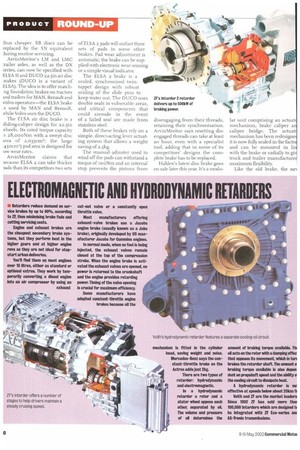ELECTROMAGNETIC AND HYDRODYNAMIC RETARDERS
Page 60

Page 61

If you've noticed an error in this article please click here to report it so we can fix it.
Retarders reduce demand on service brakes by up to 90%, according to iF, thus minimising brake fade and cutting servicing costs.
Engine and exhaust brakes are the cheapest secondary brake systems. but they perform best in the higher gears and at higher engine revs so they are not ideal for stopstart urban deliveries.
You'll find them on most engines over 10 litres, either as standard or optional extras. They work by temporarily converting a diesel engine into an air compressor by using an exhaust cut-out valve or a constantly open throttle valve.
Most manufacturers offering exhaust-valve brakes use a Jacobs engine brake (usually known as a Jake brake), originally developed by US manufacturer Jacobs for Cummins engines.
In normal mode, when no fuel is being infected, the exhaust valves remain closed at the top of the compression stroke. When the engine brake is activated the exhaust valves are opened, no power is returned to the crankshaft and the engine provides retarding power. Timing of the valve opening is crucial for maximum efficiency.
Some manufacturers have adopted constant-throttle engine brakes because all the mechanism Is fitted In the cylinder head, saving weight and noise.
Mercedes-Benz says the constant-throttle brake on the Actros adds Just 2kg.
There are two types of retarder: hydrodynamic and electromagnetic.
In a hydrodynamic retarder a rotor and a stator wheel oppose each other, separated by oil. The volume and pressure of oil determines the amount of braking torque available. Th oil acts on the rotor with a damping effec that opposes its movement, which in tun brakes the retarder shaft. The amount o braking torque available is also depen dent on propshaft speed and the ability o the cooling circuit to dissipate heat.
A hydrodynamic retarder is no effective at speeds below about 20km/i
Yoith and if are the market leaders Since 1992 iF has sold more tha 100,000 Intarders which are designed t be integrated with ZF Ece-series ani AS-Tronic transmissions. 2F has just launched intarder 2. braking power has been increased from 120 to 500kW (depending on the availsble cooling capacity) and maximum ,etardation is available over a wider ;peed band than before. Its EST 42 elec:ironic controls help minimise any fuel lenalty when idling at low speeds.
Intarder 2 is also simpler to operste, says 2F. In addition to the braking stages with constant braking torque, there is an automatic position for Wanting the braking torque to a speed evel requested by the driver; this is mown as Bremsomat. A further stage p the Bremsomatic. if the road speed as been altered by accelerating or sing the service brake, Bremsomatic sutomatically retains the new speed.
Other options Include connecting the Bremsomatic and Cruise Control to liold a constant speed when running
on the flat or uphill.
Voith's R1151I system is also partly Integrated into the transmission, so it iloes not affect the propshaft or newer take-off.
Volth prefers a separate oil circuit to eliminate the risk of heat generated by the retarder causing stress on the transmission. In some applications, says Voith, improved retardation can result because the ail can reach its maximum operating temperature and not be restricted by the capacity of the engine cooling system.
Electromagnetic retarders are popular for low-speed, stop-start operations and on small vehicles. Robin Gregg, managing director of market leader Telma, says the extra weight is as little as 60kg and the "virtually Instantaneous response time plus the high performance of the system at slow
speeds in towns and cities give very substantial Increases in brake service life and major savings in maintenance".
Telma's Focal range, which accounts for 80% of Telma UK sales, fits directly to the propshaft or it can be coupled directly on the transmission housing. This is said to
eliminate any need to alter propshaft lengths or restrict use of power takeoff units or emer gency auxiliary steering pumps. Telma has also introduced electronic controls, allowing its retarders to interface with CAN-bus wiring systems.












































































































































































